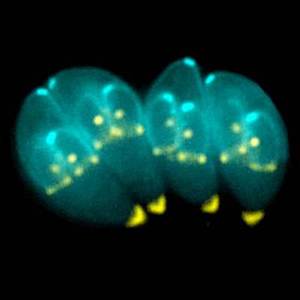A New Treatment for Toxoplasmosis

I have talked at some length about the possible link between toxoplasmosis and some forms of mental illness, but there is also another side to toxoplasmosis: the Toxoplasma gondii parasite infects nearly one-third of all humans: more than two billion people worldwide. In the United States alone, congenital toxoplasmosis occurs in an estimated 1 per 5,000 births a year and can cause severe vision loss, brain damage and even death. The human cost is incalculable, and in dollars and cents, it has been estimated that the annual cost of caring for these children may exceed $1 billion.
Toxoplasma gondii is carried by some cats and it is said that an infected cat can excrete up to 20 million oocysts over a period of two weeks, and every single oocyst is infectious. They are tenacious and can remain infectious in water for up to six months and in warm moist soil for a year of more.
Toxoplasma infects humans through three main routes:
- Consumption of undercooked, infected meat
- Ingestion of T. gondii oocysts in food, through accidental contamination from cat litter
- Finally, a newly infected pregnant woman may pass the infection to her fetus, hence the warning that pregnant women should not clean the cat box
Not only is toxoplasmosis the most common parasitic infection in the world, but also it can cause particular problems in people with compromised immune systems, for instance people with cancer, autoimmune disease, AIDS or transplant recipients.
It is even possible for people with normal immune systems to suffer major organ damage from chronic infections. Eye disease leading to loss of sight can be caused both a primary infection and as a result of infection transmitted from mother to child. Damage to other organs has recently caused deaths among otherwise healthy young people during epidemics in Surinam and French Guiana.
The parasites that cause malaria are related to Toxoplasma gondii, and a new drug that will soon enter clinical trials for the treatment of malaria also appears to be 10 times more effective than the current gold-standard treatment of toxoplasmosis, a combination of the drugs pyrimethamine and sulfadiazine.
In the March issue of PLoS Neglected Tropical Diseases, a research team based at the University of Chicago Medical Center reports that the drug, known as JPC-2056, is extremely effective against Toxoplasma gondii, both in cell culture and in mice, and apparently without the toxicity associated with the current standard treatment.
The drug works inhibiting the action of the from of the enzyme dihydrofolate reductase (DHFR) that is produced by the family of parasites that includes those that cause toxoplasmosis and malaria, and in cell culture studies, the drug appears actually to kill the parasite, rather than simply preventing its replication. This is very important: not only do most of the current medications have a good many side effects, they have little effect on Toxoplasma during certain phases of its life cycle. It can hunker down in the quiescent cystic phase and wait until the antibiotics are gone.
Rima McLeod, professor of ophthalmology and specialist in infectious diseases at the University of Chicago said,
“JPC-2056 has the potential to replace the standard treatment of pyrimethamine and sulfadiazine. Taken by mouth, is easily absorbed, bioavailable, and relatively nontoxic. In tissue culture and in mice, it was rapidly effective, markedly reducing numbers of parasites within just a few days.”
JPC-2056 is not a new drug. It was developed in the late 1980s by teams led by Wilbur Milhous and Dennis Kyle of the Walter Reed Army Institute for Research and David Jacobus of Jacobus Pharmaceutical Company. The original version was quite toxic, but the researchers found ways to reduce the toxicity and developed an oral version of the drug. Clinical trials using JPC-2056 to treat malaria are scheduled to begin later this year.






